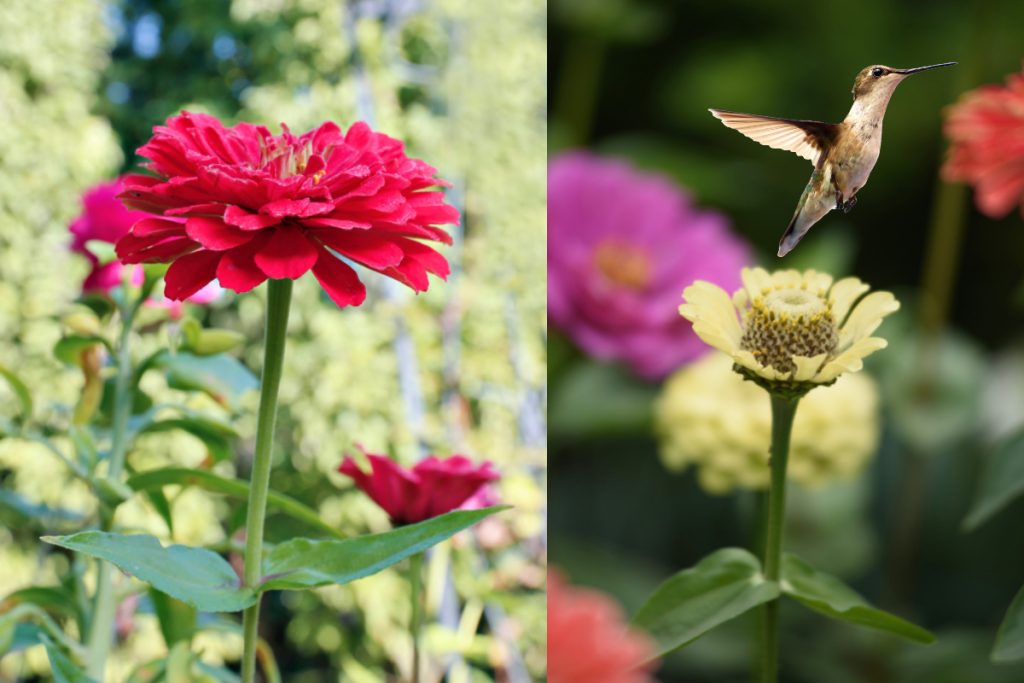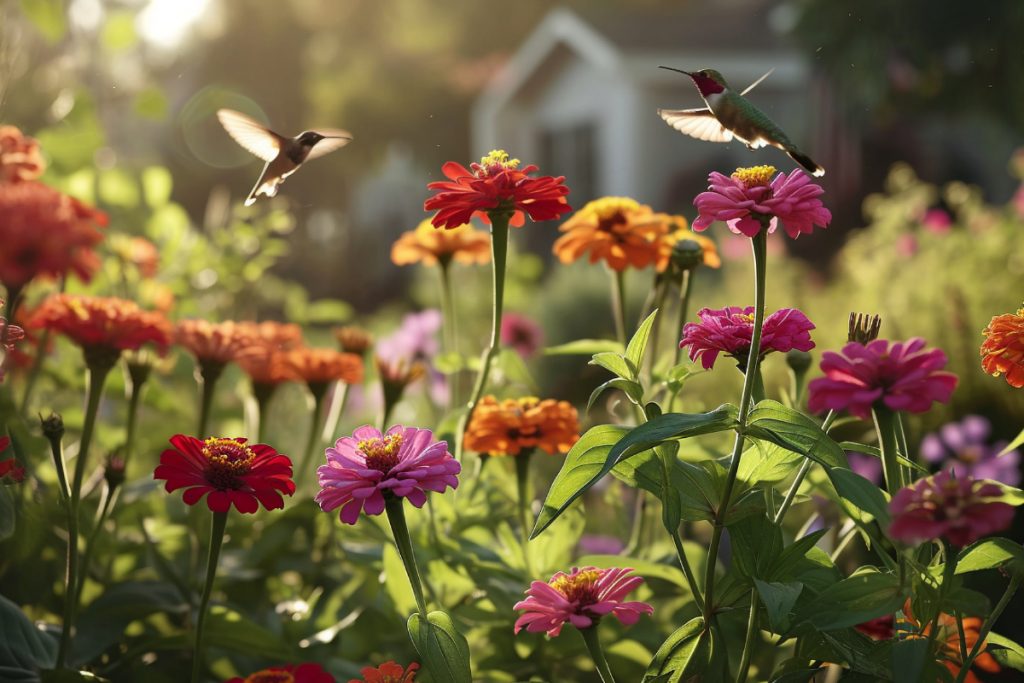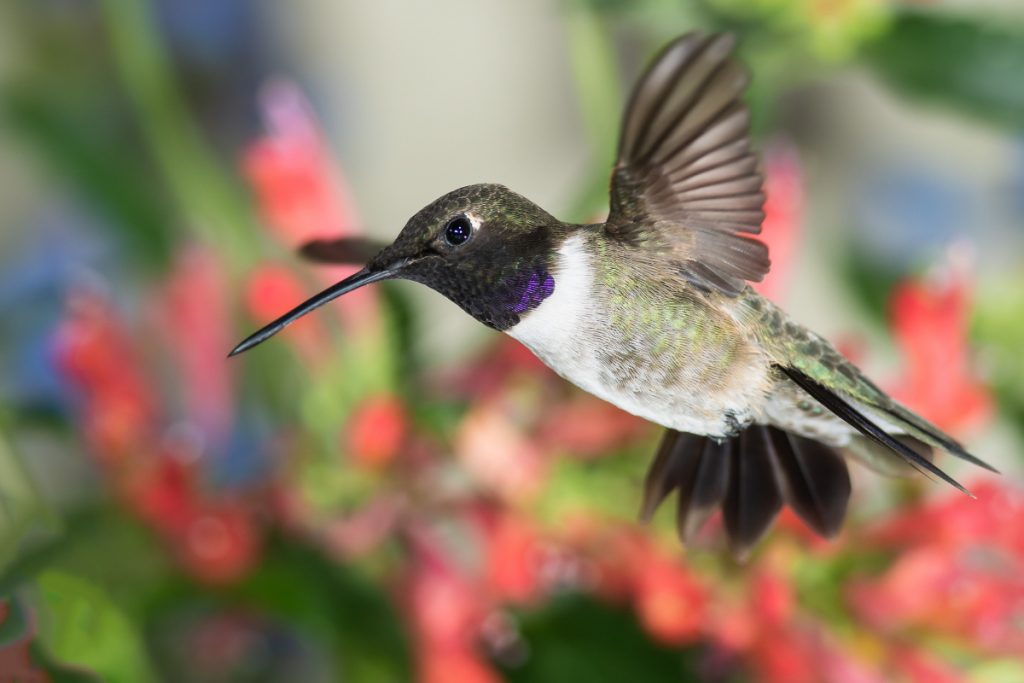If you enjoy watching hummingbirds flit around your garden, you may wonder what flowers will attract these captivating birds. As someone who loves gardening and loves hummingbirds myself, I set out to research which flowers attract these tiny birds the most.
After spending days researching and talking to horticulturists, the zinnia was one flower that kept coming up. Most interestingly, the zinnia flowers‘ ability to attract hummingbirds is one of their essential qualities and what they are also known for.
Do Hummingbirds Like Zinnia Flowers?
Yes, hummingbirds are very fond of zinnia flowers. With their bright colours and abundant nectar, Zinnias are attractive to these birds. The flashy reds, oranges, and pinks of zinnias catch the hummingbirds’ eyes, leading them to the flowers.
Additionally, the shape and size of zinnia blooms are suitable for hummingbirds to feed on their nectar easily. Planting a group of zinnias in your garden can create a lively spot for these beautiful birds to visit.
Related Post To Read: 33 Top Plants That Attract Hummingbirds.

- Do Hummingbirds Like Zinnia Flowers?
- Introduction to Zinnias Flower
- Why Hummingbirds Love Zinnias
- Growing Zinnias to Attract Hummingbirds
- Final Thoughts
- Frequently Asked Questions About Zinnias for Hummingbirds
- Q: How many zinnia plants are needed to attract hummingbirds effectively?
- Q: Should I grow zinnias from seeds or use transplants?
- Q: Which colours of zinnias are most attractive to hummingbirds?
- Q: Are zinnias annual or perennial plants?
- Q: Is deadheading zinnias necessary?
- Q: What are some effective zinnia varieties for attracting hummingbirds?
- Q: Can you describe hummingbird behaviour in zinnia gardens?
- Q: What companion plants are beneficial alongside zinnias?
- Q: What conditions do zinnias thrive in?
- Q: How should I manage pests and diseases in zinnia gardens?
- Q: What are the best practices for watering and fertilising zinnias?
- Useful Links:
Related post to read: Do Hummingbirds Like Marigolds?
Introduction to Zinnias Flower
Zinnias are hardy annual flowers that come in a staggering range of sizes, colours, and bloom shapes. Despite this diversity, all zinnias produce copious amounts of nectar that generally appeal to hummingbirds.
Zinnias are native to Mexico’s hot, dry regions and the American Southwest. After centuries of selective breeding, over 100 vibrantly coloured varieties now exist.
Today’s garden zinnias trace their ancestry back to just a few species within the Zinnia genus, predominantly Zinnia elegans. There are literally hundreds of zinnia cultivars to choose from, classed into groups based on their growth habit and flower form.
Their heights range from 6 inches for carpet bedding types to an impressive 4 feet for giant dahlia-flowered cultivars.

Why Hummingbirds Love Zinnias
There are several key reasons why hummingbirds flock to zinnias:
Brightly Coloured Flowers
Hummingbirds possess incredible colour vision unmatched by other birds. They can see wavelengths of light invisible to humans, detecting ultraviolet pigments in flowers. This allows hummingbirds to zero in on blossoms with the richest nectar guides. These lines and dots act as bulls-eye targets, pointing the way to sweet rewards.
Zinnias come in a rainbow of intense hues, from crimson red to sunset orange, hot pink to sunshine yellow. Many feature dramatic colour contrasts on petals, with dark centres or picotee edges. These vivid blooms cannot fail to catch a hummingbird’s eye across a garden.
Tubular Flower Shape
Hummingbirds have slender beaks perfectly designed for probing into tubular flowers. As they hover in front of blossoms, hummingbirds carefully insert their long tongues deep inside to lap up nectar.
Zinnias have central discs made up of hundreds of tiny, closely packed florets. This cluster of mini tubular flowers is ideal for hummingbirds to delve into. The nectar is produced at the base of each tiny floret. A hummingbird deftly touches its tongue to each in rapid succession to accumulate sweet droplets.
Abundant Nectar
Hummingbirds have extremely high metabolisms. To fuel their wings beating up to 70 times per second, they must consume enormous quantities of high-energy nectar.
The volume of nectar produced varies widely across zinnia varieties. Generally, the larger the flower head, the greater its nectar output. Giant dahlia-flowered zinnias yield the most of all. Even smaller flowered bedding types produce enough sweet liquid to satisfy hummingbird appetites.
Long Flowering Season
Hummingbirds neither hibernate in winter nor migrate far. To survive year-round, they rely on a sequence of nectar-rich blooms from early spring through late fall.
One of the best features of zinnias is their long flowering season. Sow seeds in spring for flowers from summer onwards. Staggered planting dates extend the display. Deadheading also promotes re-blooming. With careful planning, your zinnias can provide nectar for months.

Growing Zinnias to Attract Hummingbirds
One reason zinnias are so widely grown is they are among the easiest annual flowers you can cultivate, even for beginners. Here are the top tips for successfully raising zinnias that will entice hummingbirds to linger.
Choosing Varieties
With so many types of zinnias available, deciding which to grow can seem daunting. As a general rule, select a range with varying heights, colours, and bloom periods. This will provide an ongoing nectar supply from midsummer into fall.
For small spaces, dwarf bedding zinnias work well. They create vibrant carpets of colour that hummingbirds buzz over. Larger gardens suit tall cutting types with big, showy flower heads. These generate more nectar than compact varieties.
Do not overlook old-fashioned single-flowered kinds. Their sparse petals allow easier access for long hummingbird beaks. Just ensure there is adequate air movement around plants to prevent powdery mildew from attacking open blooms.
Sowing and Growing
Zinnias germinate readily from seeds sown directly in the garden after final spring frosts. Space plants well apart to enable good air circulation between them. Water at the soil level rather than overhead to keep foliage dry and deter diseases.
If starting seeds indoors, use peat or paper pots to avoid disturbing roots later on. Harden off young plants fully before transplanting outside once night temperatures remain above 50°F. Shelter seedlings initially to prevent wind and heavy rain from damaging stems.
Position zinnias where they will receive full sun for at least six hours daily. They thrive in well-drained, fertile soil and hot conditions. Add organic matter like compost when preparing planting sites in spring. Apply a balanced granular fertiliser once flowering commences to support heavy bud production.
Deadheading and Maintenance
The more zinnias bloom, the more nectar they will provide for hummingbirds. Deadhead flowers as soon as they fade to encourage further flowering instead of seed heads forming. Always use clean, sharp secateurs to avoid damaging stems.
Monitor plants for pests like spider mites. Hose down foliage to dislodge them or use insecticidal soap sprays. Remove any infected leaves or flowers promptly to stop diseases from spreading. Stake tall varieties to prevent wind and rain from battering them.
Planting for Success
Group zinnia plants together in blocks rather than dotting them randomly around your garden. Clumped formations help attract hummingbirds and provide decent quantities of nectar in one convenient location.
Include other tubular flowers beloved by hummingbirds nearby, like fuchsias, salvias, and penstemons. Position feeders stuffed with sugar water close to zinnia plantings, too. Site them near trees or shrubs where hummingbirds can rest between feasts.
Finally, always avoid using pesticides or insecticides, even natural ones. Hummingbirds can be harmed by residues left on foliage and flowers. With these simple steps, you will soon enjoy a garden filled with zinnias abuzz with active hummingbirds.
Final Thoughts
If you want to see elegant hummingbirds hovering as they feed, include plenty of bright, nectar-rich zinnias in your garden, as discussed earlier in this post. These hardy, easy-care flowers will have the birds flocking back for repeat visits.
With the tips discussed in this blog post, you can raise a range of zinnia varieties suited to your garden size and climate. Then sit back and relax as you watch mesmerising hummingbirds enjoy your handiwork all season long!

Frequently Asked Questions About Zinnias for Hummingbirds
Q: How many zinnia plants are needed to attract hummingbirds effectively?
A: A single zinnia can attract hummingbirds, but planting a group of three or more enhances visibility and nectar availability. Ensure they are spaced to allow full growth.
Q: Should I grow zinnias from seeds or use transplants?
A: Directly sowing seeds in the garden is recommended to avoid disturbing the taproot. In cooler climates with shorter seasons, use transplants, planting them at their original soil level and sheltering them until established.
Q: Which colours of zinnias are most attractive to hummingbirds?
A: Hummingbirds are drawn to red, orange, and bright pink zinnias due to their high visibility, but they will visit zinnias of all colours.
Q: Are zinnias annual or perennial plants?
A: Zinnias are annuals. They complete their lifecycle in one season and can self-seed for growth in the following spring.
Q: Is deadheading zinnias necessary?
A: Yes, deadheading encourages more blooms and prevents energy waste on seed production. Snip above a leaf joint, or for lower varieties, pinch out the whole spent head.
Q: What are some effective zinnia varieties for attracting hummingbirds?
A: ‘Profusion’, ‘Zahara’, and ‘Benary’s Giant’ are excellent choices, known for their vibrant colours and nectar richness.
Q: Can you describe hummingbird behaviour in zinnia gardens?
A: Hummingbirds hover and dart around, extracting nectar with their long beaks. They’re particularly active in the early morning and late afternoon and may show territorial behaviour.
Q: What companion plants are beneficial alongside zinnias?
A: Salvia, petunias, and bee balm make great companion plants, offering additional nectar sources and garden diversity.
Q: What conditions do zinnias thrive in?
A: Zinnias prefer well-drained soil and need full sun exposure for 6-8 hours daily. They tolerate high heat, ideal for summer planting.
Q: How should I manage pests and diseases in zinnia gardens?
A: Inspect regularly for pests like aphids and spider mites, using insecticidal soap or neem oil as needed. To prevent diseases like powdery mildew, ensure good air circulation and avoid wetting foliage when watering.
Q: What are the best practices for watering and fertilising zinnias?
A: Water at the base to keep foliage dry, allowing the soil to dry slightly between waterings. Use a balanced, slow-release fertiliser at the start of the season for healthy growth.
Useful Links:
Related Posts to Read:
- Do Hummingbirds Beaks Open When Feeding?
- The Mysteries of Hummingbird Flight.
- 6 Fascinating Facts About Hummingbird Sizes.
- Ruby-Throated Hummingbird Migration Map.
- Where Do Hummingbirds Go When It Rains?
- How Much Does A Hummingbird Eat Per Day?
- Hummingbird Diet and Nutrition.
References:
- About Hummingbird (Link).
- Greenewalt, C. H. (1960). Hummingbirds. New York: Doubleday. Google Scholar.
- Carey C. The impacts of climate change on the annual cycles of birds. Philos Trans R Soc Lond B Biol Sci. 2009 Nov 27; 364(1534):3321-30. doi: 10.1098/rstb.2009.0182. PMID: 19833644; PMCID: PMC2781852.
- Rico-Guevara A, Rubega MA, Hurme KJ, Dudley R. Shifting Paradigms in the Mechanics of Nectar Extraction and Hummingbird Bill Morphology. Integr Org Biol. 2019 Jan 2;1(1):oby006. doi: 10.1093/iob/oby006. PMID: 33791513; PMCID: PMC7671138.
- Tyrrell LP, Goller B, Moore BA, Altshuler DL, Fernández-Juricic E. The Orientation of Visual Space from the Perspective of Hummingbirds. Front Neurosci. 2018 Jan 30;12:16. doi: 10.3389/fnins.2018.00016. PMID: 29440985; PMCID: PMC5797624.
- Hummingbirds Sighting (Journey North Map).
- About Hummingbird’s Characteristics.
